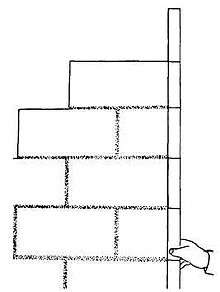Storey pole

A storey pole (or story pole, storey rod,[1] story stick,[2] jury stick,[3] scantling,[4] scantillon[5]) is a length of narrow board usually cut to the height of one storey.[6] It is used as a layout tool for any kind of repeated work in carpentry including stair-building, framing, timber framing, siding, brickwork, and setting tiles. The pole is marked for the heights from (usually) the floor platform of a building for dimensions such as window sill heights, window top heights (or headers), exterior door heights (or headers), interior door heights, wall gas jet heights (for gas lamps) and the level of the next storey joists. It makes for quick, repeatable measurements without the need of otherwise calibrated measuring devices or workers skilled in using them.
Craftsmen use them to mark clapboard and brick courses so that, for example, a course ends neatly below a window sill or at a door's architrave. They are used in remodelling so that, for example, the new coursing of exterior siding on a wing will match the existing.[7]
There is evidence of 'boning-rods' being used in building Egypt's Great Pyramid as counterparts of modern storey poles.[8]
References
- ↑ "storey". Oxford English Dictionary. Sep 2015.
- ↑ Carlsen, Spike (2012). Woodworking FAQ: the workshop companion: build your skills and know-how for making great projects. North Adams, MA: Storey Publishing. p. 65. ISBN 978-1-60342-729-6.
- ↑ Nash, George (1995). Do-it-yourself housebuilding: the complete handbook. New York: Sterling Pub. Co. p. 601. ISBN 978-0-8069-0424-5.
- ↑ "scantling". Oxford English Dictionary. Dec 2016.
- ↑ "scantillon". Oxford English Dictionary. Sep 2016.
- ↑ "Apprentices' Column". The Builder and Wood-Worker. Vol. 20. New York: Fred A. Hodgson. Aug 1884. p. 157. Retrieved 2016-12-11.
- ↑ Leeke, John (Sep–Oct 1994). "Recreating Historic Siding with Modern Materials". Old House Journal. Vol. 22 no. 6. Active Interest Media, Inc. pp. 32–36. ISSN 0094-0178. Retrieved 2016-12-11.
- ↑ Isler, Martin (1983). "Concerning the Concave Faces on the Great Pyramid". Journal of the American Research Center in Egypt. 20: 27–32. doi:10.2307/40000899.